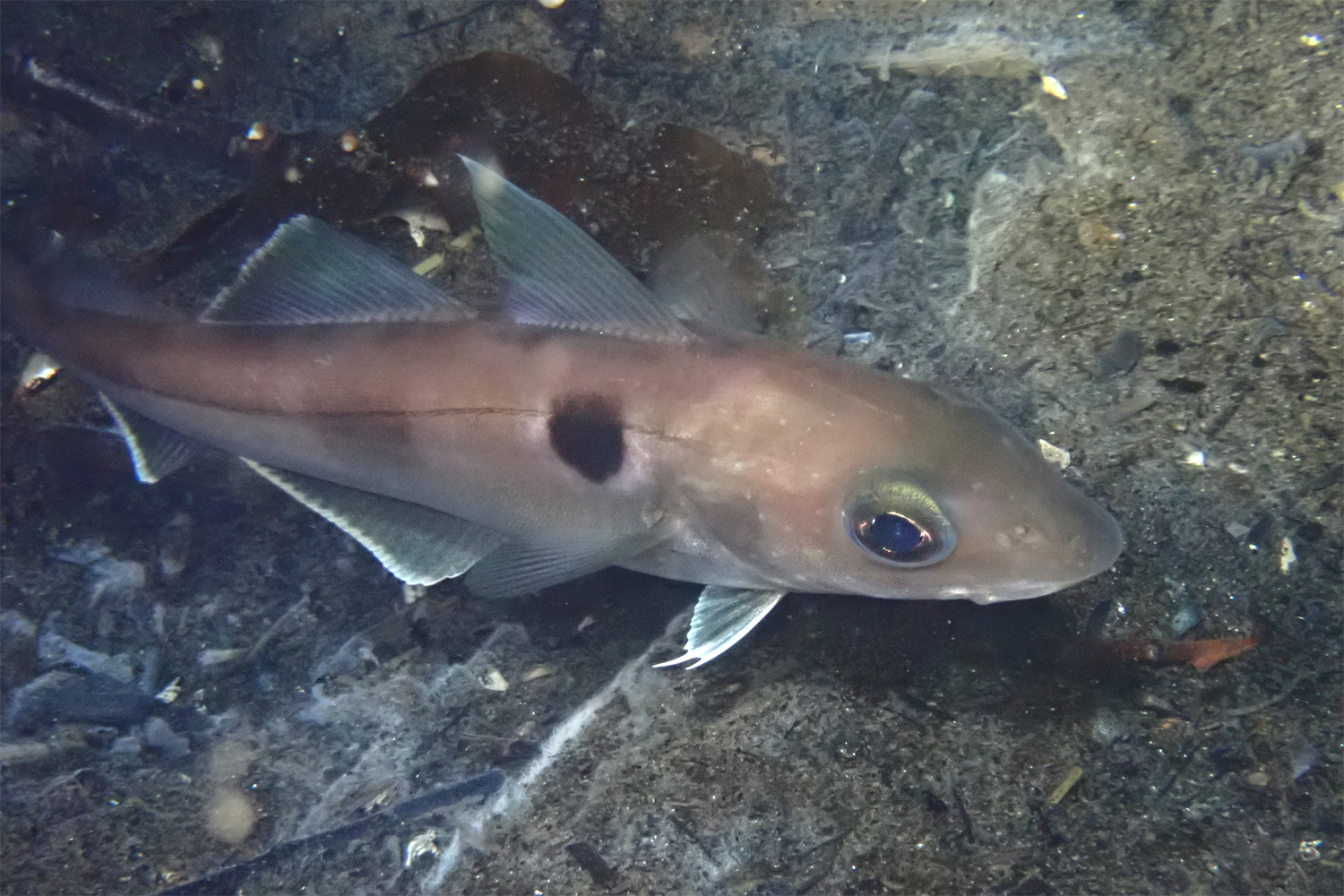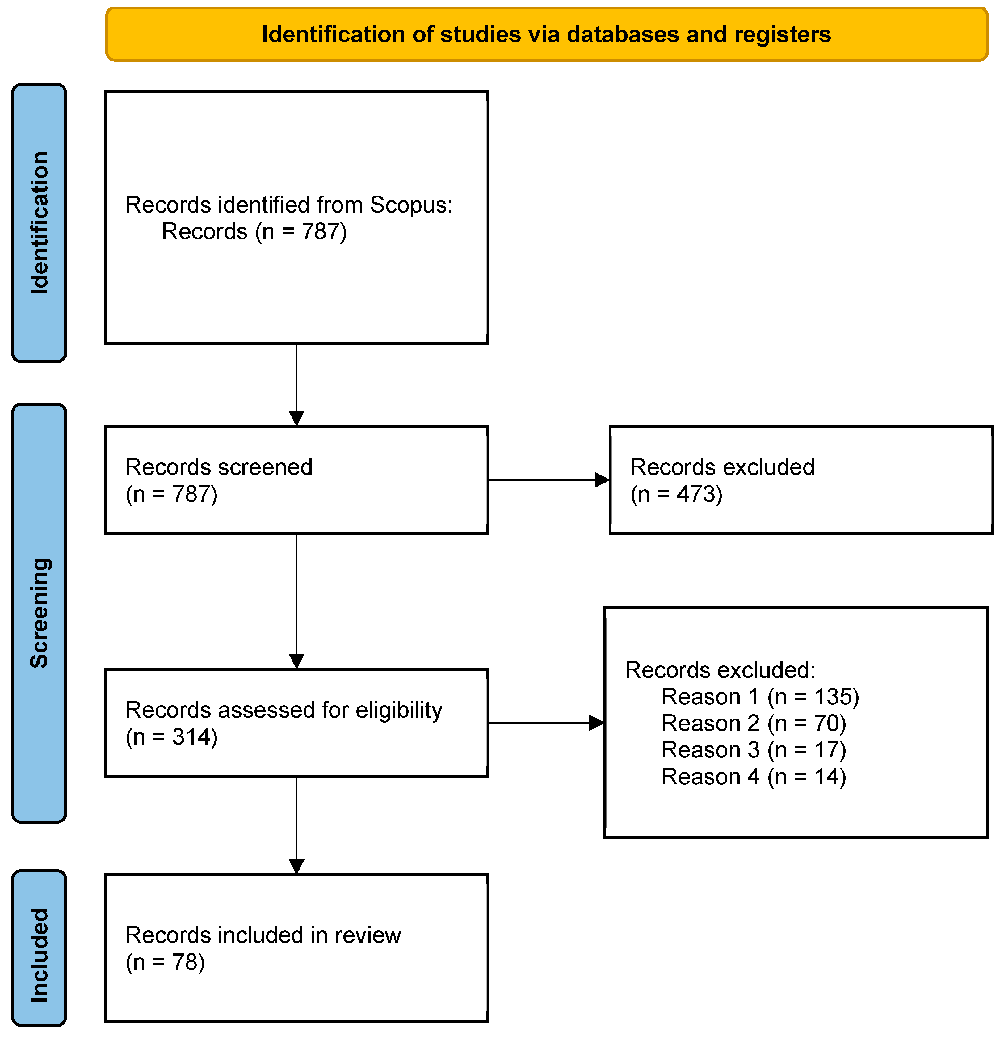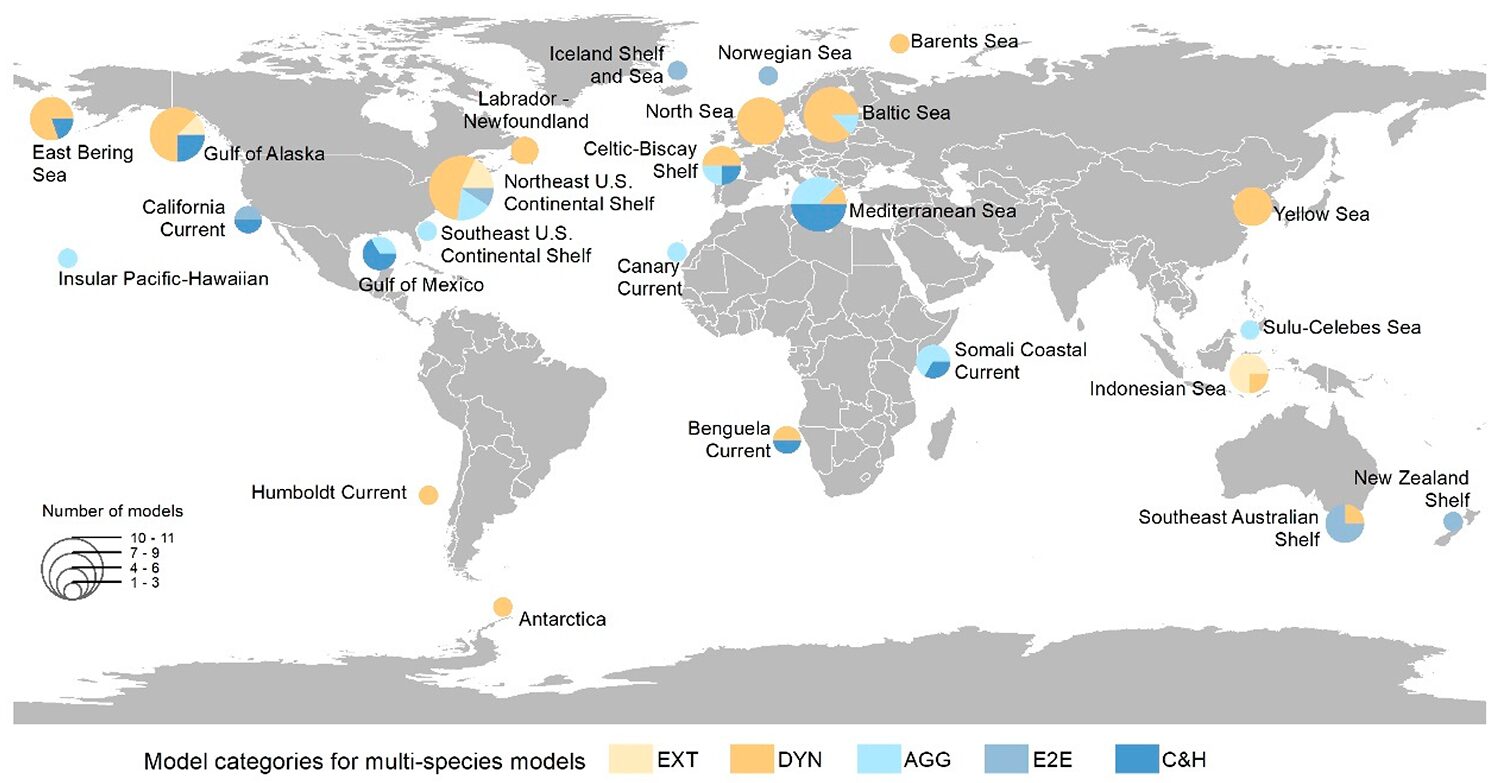Guide for stakeholders, decision makers and scientists to understand existing work on multi-species models

Traditionally, marine fisheries management has relied heavily on single-species population models to guide the development of measures aimed at ensuring the sustainability of fisheries resources. These models typically focus on key population dynamics, including growth rate, recruitment, selectivity, biomass, natural mortality, and fishing mortality. The interplay of these factors determines the fluctuations in the population size of target species over time.
Beyond single-species population models, fisheries management increasingly employs more complex models, such as ecosystem models. These models aim to account for broader ecological processes, including biological interactions between species, which is a core aspect of multi-species models. An ecosystem model (EM) is a framework that incorporates ecosystem components (e.g., species or functional groups) and ecological processes (e.g., predation, perturbations, and dispersal), using data to make inferences about specific elements or the entire ecosystem. These models, often visualized as networks, help predict outcomes of complex ecological interactions and are widely used in marine and terrestrial management.
Multi-species models (MSMs) can model trophic interactions, competition, predation, and other ecological dynamics, and are primarily used for strategic advice in fisheries management, informing long-term decisions and bracketing a range of viable options. The use of MSMs has expanded to various other purposes; for example, in the US Atlantic and the Irish Sea, these models have been employed to adjust single-species management reference points, considering multispecies interactions and enhancing ecosystem understanding. Many studies have advanced our understanding of these tools, but a systematic assessment of how MSMs are related to the geographical areas in which they are applied remains lacking.
This article – summarized from the original publication (Couve, P. et al. 2024. Systematic Review of Multi-Species Models in Fisheries: Key Features and Current Trends. Fishes 2024, 9(10), 372) – reports on a comprehensive review of the application of multi-species models in fisheries research, highlighting their geographic and species-specific uses.
This study involved a literature review on multi-species models (MSMs) conducted using Elsevier’s Scopus database (www.scopus.com, accessed on 23 November 2022). The review methodology followed the PRISMA (Preferred Reporting Items for Systematic Reviews and Meta-Analyses) guidelines. PRISMA is a standardized framework that helps ensure clear and complete reporting of research methods and findings for systematic reviews and meta-analyses. The PRISMA approach involves the use of a checklist and a flow diagram to promote transparent and comprehensive presentation of the research process and results.
The systematic review search formula yielded a total of 787 articles. From these, only 78 articles met the eligibility criteria described and were fully reviewed (Fig. 1). A total of 86 MSMs were identified across the 78 articles reviewed.
For detailed information on the study design, data acquisition and analyses, refer to the original publication.

Regional interest in multi-species models
The majority of the 86 MSMs identified were classified as dynamic multi-species models, DYN (models which use a limited number of species or functional groups that are likely to have relevant interactions with the target species), accounting for 45 cases. The models compiled in this study are associated with 25 of the 66 Large Marine Ecosystems (LMEs) identified globally, representing 38 percent of the total. The distribution of MSMs is primarily concentrated in North America and Europe (Fig. 2). The disproportionate distribution of fisheries publications can be attributed to the concentration of research output from a small number of established fisheries science centers, primarily located in Europe, North America, Australia, and Japan.

In the MSMs reviewed, the choice of species is not only based on their capture volume or commercial value. Instead, it is also influenced by their historical significance in research. These model organisms are well-studied, allowing for more straightforward exploration of biological and ecological questions.
North Sea
In addition to haddock, herring, and Atlantic cod, the MSMs found in the review also included other species that constitute a large portion of the landings in the North Sea, such as whiting, Norway pout and sandeel. It is worth noting that the North Sea LME is home to more than 100 stocks. The difficult recovery of the Atlantic cod population over the years was also a key driver for the use and development of MSMs in this LME. These models addressed the complex interactions between species and the potential impacts of climate change on the ecosystem. The development and application of MSMs in the North Sea LME reflect the stakeholders’ concerns about achieving sustainable fisheries management, while also accounting for the multi-species dynamics and the effects of environmental changes on the ecosystem.
Baltic Sea
The Baltic Sea is characterized by a well-documented interaction between three commercially important species: Atlantic cod, sprat, and herring. These species have overlapping distributions, particularly in ICES subdivisions 25–29 and 32, and together, they account for approximately 95 percent of the total catches in the region. The Baltic Sea is known to be susceptible to environmental changes, which further contributes to the relevance and exploration of MSMs in this LME.
Gulf of Alaska
The pollock fishery is the largest groundfish fishery in the Gulf of Alaska (GoA). Pollock, along with Pacific herring, are major prey species for Pacific cod and arrowtooth flounder, making them key components of the GoA ecosystem and fisheries. In trawl fisheries, species such as Pacific halibut are designated as prohibited species catch, with limited quota allocations. However, this management approach has not led to drastic decreases in catch limits for other fish species. Halibut is an important predator in the GoA ecosystem, particularly for older individuals that have already entered the commercial fishery.
Mediterranean Sea
Traditionally, fisheries management in the Mediterranean Sea (MED) has relied on effort control and technical measures, such as area restrictions, minimum landing sizes, and gear limitations, with no catch limits and technical interactions in many fisheries. This approach, combined with the complexity of managing the 23 countries surrounding the MED and the multiple anthropogenic and environmental stressors negatively impacting fish stock populations, has created a critical situation due to the current state of overexploitation of several commercial fisheries.
European hake is the species most frequently encountered in the MSMs of this LME. This is because European hake has a wide spectrum of prey, with smaller individuals (less than 12–13 cm total length), exhibiting no particular preference towards certain taxa, while larger individuals specialize in more energy-rich and larger prey, such as sardines, European anchovies, or even small hakes. In contrast, sardines and European anchovies are prey for multiple predators, sustaining higher trophic levels and making them subjects of study to evaluate trophic dynamics in different scenarios for the region.
Gulf of Maine
The Gulf of Maine (GoM), particularly the Georges Bank, was the most frequently mentioned area for the U.S. East Coast Large Marine Ecosystem in the reviewed models. In this region, Atlantic cod preys on Atlantic herring and juvenile Atlantic cod. Meanwhile, Atlantic menhaden is preyed upon by several species, including large fishes such as striped bass and Atlantic bluefin tuna, as well as marine mammals like the bottlenose dolphin. In addition to supporting commercial fisheries, some of these predator species have significant value in recreational fisheries, ecotourism, and cultural heritage.
Multi-Species Model Groups
The groups of models shown in Fig. 3 incorporate different sets of features. Even within the same MSM category, there can be significant variation in the specific features that different MSMs utilize. In this review, only seven features were considered for each MSM.

Choosing the appropriate functional response model is crucial, as an erroneous choice can lead to either underestimating or overestimating the risk of stock impairment, rather than capturing the more realistic stock dynamics. This is because the model output is highly sensitive to the functional response used.
Complex ecosystem models, such as Atlantis, can incorporate multiple functional response models, allowing each species to be represented by the most suitable functional response based on predator behavior. This flexibility in the functional response modeling helps to better capture the underlying predator–prey interactions. However, this is contingent upon the complexity of the model, as conducting a comprehensive sensitivity analysis to evaluate alternative forms of functional responses is challenging.
Given the potential impact of climate change, which could reduce global fish biomass by up to 30 percent by 2100 under one of the scenarios considered, several of the revised MSMs have addressed the effects of climate variability on the productivity of marine species. These models employ various approaches depending on the MSM category. A top-down approach, often associated with fisheries management, examines how variables such as temperature-dependent predation, foraging, metabolic, and growth rates influence the development of the target species. This approach is commonly implemented in dynamic models or end-to-end models. Conversely, a bottom-up approach focuses on understanding how environmental drivers affect populations. This method is more prevalent in coupled and hybrid platforms, utilizing several submodels to capture the complexity of these interactions.
Ecosystem models face uncertainty from both parameters estimates and structural components, increasing with model complexity, but simpler models also have limitations like key process omission and inappropriate scales. Validating ecosystem models is inherently challenging because creating ideal experimental setups for these complex models often requires a wide range of treatment and control scenarios, as well as significant temporal and geographic scope. Given the inherent complexity of MSM category, conducting a comprehensive sensitivity analysis to assess alternative configurations may prove to be overly intricate. Specifically, cross-validating model predictions across multiple modeling approaches can be a potent tool for mitigating uncertainty in decision-making processes.
Perspectives
Managing mixed fisheries effectively remains a significant challenge. While the need for improved approaches is clear, most frequent applications of multispecies and ecosystem approaches have been observed in the Northern Hemisphere, particularly North America and western Europe. These initiatives, driven by the goal of advancing towards the next generation of ecosystem-based fisheries management, have focused on culturally and commercially important fisheries, particularly those targeting small pelagic and demersal species. This geographic and species focus underscores the need to acknowledge the most significant predator-prey interactions, especially those involving small pelagic fish.
This work shows sustained development and application of MSMs incorporating predation dynamics for fishery management and research. Our results serve as a comprehensive guide for stakeholders, decision makers and scientists to review existing work related to multi-species models. It offers insights into their adoption in fisheries management and research, considering data availability and regional development.
Now that you've reached the end of the article ...
… please consider supporting GSA’s mission to advance responsible seafood practices through education, advocacy and third-party assurances. The Advocate aims to document the evolution of responsible seafood practices and share the expansive knowledge of our vast network of contributors.
By becoming a Global Seafood Alliance member, you’re ensuring that all of the pre-competitive work we do through member benefits, resources and events can continue. Individual membership costs just $50 a year.
Not a GSA member? Join us.
Author
-
Pablo Couve, M.S.
Corresponding author
Institut de Ciències del Mar (ICM-CSIC) Consejo Superior de Investigaciones Científicas, 08003 Barcelona, Spain; and Faculty of Earth Sciences, Universitat de Barcelona, 08028 Barcelona, Spain



